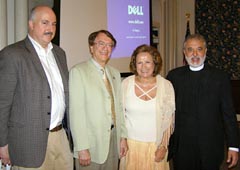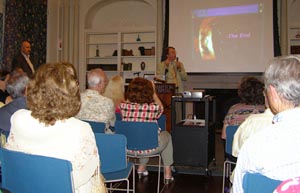 |
||
|
Dr. Krimigis Presents Space-and-Beyond Lecture |
||
| Science fiction movies such as "Asteroid" show the danger from outer space. How can earth protect itself from asteroids so we are not destroyed as the dinosaurs during the Jurassic Age? The unpublicized fact is that we have a means of detecting an asteroid assault and destroying it in space. These instruments have already been created in an American laboratory. By whom? A Greek immigrant from Vrontado, Chios! Yes, Chios the island of masticha, ouzo, shipowners, bouzouki and monasteries has given the world a modern day Archimedes. His name is Dr. Stamatios M. Krimigis, probably one of the top scientists of our Modern Age. |
||
| The 2006 annual Sophocles and Louisa Zoullas Hellenic Lecture hosted Dr. Krimigis's lecture entitled "Space and Beyond." The event was on Saturday evening, July 22nd, at Parrish Memorial Hall of Southampton Hospital. A reception preceded the event with Greek appetizers and desserts. Over one hundred persons from every professional and business field attended. All came, regardless of the fierce storm warnings on the East End, to hear this unique astronomer. Chiotes from the New York City area attended to support the Lecture Chairperson, Dr. Peter Michalos, whose Chiote grandfather was one of the Evzone guards of the Greek Nation. |
 Dr. Krimigis (second from left) with Dr. Peter Michalos (left to right), Evelyn Ikonomopoulos and Rev. Alexander Karloutsos at lecture. |
|
| Dr. Krimigis described: the Cassini Program launched in October 1977; its arrival in Saturn, July 2004; the release of a probe in January 14, 2005 on Saturn's moon, Titan to discover whether the surface is solid or liquid; the Voyager programs and slides. Dr. Krimigis's greatness lies in his ability to communicate in simple terms complex ideals. |
||
|
 Dr. Krimigis showing slides of the Cassini Mission to Saturn. |
|
"Aristarchos of Samos was the first person who supported a sun centered universe," Dr. Krimigis explained. "He lived from 310-230 B.C., before Copernicus. The ancient Greek was close in determining the size and distance of the moon. The Voyager mission took photos of Jupiter, Saturn, Uranus, Venus, Mars, Mercury and Pluto." The Voyager 1 was launched on September 5, 1977. It changed our understanding of the solar system. The Cassini mission and probe has explored Saturn and its moon Titan, which has a primitive earth like atmosphere. For more information on the Voyager and Cassini missions, visit internet links voyager.jpl.nasa.gov and http://saturn.jpl.nasa.gov/overview/index.cfm. "It's a tough job to go to the hottest planet (Mercury) and to Pluto (The coldest planet)," said Dr. Krimigis. "Pluto has two or more moons. The space craft built to orbit Mercury needs a lot of rocket fuel. There is a need to generate power at high temperatures. The New Horizons spacecraft to Pluto is a new beginning in outer planet research. New Horizons is demonstrating that exciting, lower cost planet missions exist. The launch of the New Horizons spacecraft to Pluto from Cape Canaveral took place on Jan. 19, 2005. It will reach Pluto on 2015. There are Deep Face network antennas in Madrid, Australia and the U.S. for the purpose of receiving data." "The Voyager spacecraft, that was launched in 1977 was redirected to Uranus in 1986 and Neptune in 1989," explained the scientist. "The mission's data shows a great red spot, indicating hurricanes. Three earths could fit in the red spot. Jupiter has three moons: Io, Europe and Ganymede. Io has active volcanoes. Europa is icy with water oozing from ice. There is biological activity under the ice. Jupiter has a magnetic field and an aurora that burnt a spot on the upper part of the planet. The intensity of radiation can kill a person in three hours." The Cassini mission was explained with emphasis on the space probe that landed on Saturn's moon Titan on January 2005. During the journey to Saturn, the scientists woke up the probe every 6 months to check that all was well. "The sun is the last frontier," said Dr. Krimigis. "A solar probe will be launched May 26, 2013." Dr. Krimigis is Head of the Space Department of the John Hopkins University Applied Physics Laboratory from 1991 to the present. The Space Department's work includes the design, construction, testing and launching into space of entire satellites, and scientific instruments that perform measurements on earth orbiting and interplanetary missions. Dr. Krimigis has been Principal Investigator or Co-Investigator on several NASA spacecraft, including the Low Energy Charged Particle (LECP) Experiment on voyagers 1 and 2, the Active Magnetospheric Particle Tracer Explorers (AMPTE) and the Advanced Composition Explorer (ACE). He is currently Principal Investigator for the 1997 Cassini Mission to Saturn and Titan. The scientist is the Co-Investigator on Galileo, Ulysses and MESSENGER missions. He spearheaded the establishment of NASA's Discovery program for low-cost planetary missions. Dr. Krimigis has built instruments that have flown to seven of the nine planets. He is the only scientist to do so and is now working on missions to Mercury and Pluto to complete the set. In 2003, his instrument on Voyager 1 identified the approach of the solar system boundary at ~85 AU, the first spacecraft to ever do so. He has published more than 330 papers in Journals and books. The scientist has received over twenty NASA Group Achievement Awards for Voyager, AMPTE, Galileo, Ulysses, NEAR, ACE and Cassini. He has received countless honors, including the 2004 Homeric Award from the Chian Federation. The International Astronautical Union in 1999 named an asteroid 8323 Krimigis. He is often quoted in national and international media on space science and technology issues. His most recent work is on the Voyager crossing of the heliospheric Termination Shock and the Cassini orbiter of Saturn. His work on VOYAGER has been front-page news in the New York Times three times, as well as other newspapers and magazines world wide. Dr. Krimigis's resume can be accessed on the Koimisis Tis Theotokou of the Hamptons website at Panayiashamptons@verizon.net. Other exciting websites include:
|
||
 Irene Michalos, of the community's youth, with her father, Dr. Peter Michalos (left to right) and Dr. Stamatios Krimigis. |
This unique lecture series was created by Nick Zoullas in memory of his parents, Socrates and Louisa. The Zoullas, who are now deceased, were philanthropists in Athens during the German occupation of W. W. II. They opened soup kitchens to save their starving compatriots. They worked behind the scenes in their Southampton community, helping the hospital and Kimisis Tis Theotokou Church. Nick Zoullas is commended for bringing culture and intellectual brilliance to the East End through his lecture series. The President of the Parish Council is Dimitrios Hatgistavrou. Rev. Alexander Karloutsos is the protopresbyter.
|
|
|
(Posting date 02 August 2006) HCS encourages readers to view other articles and releases in our permanent, extensive archives at the URL http://www.helleniccomserve.com/contents.html. |
||
|
||
|
2000 © Hellenic Communication Service, L.L.C. All Rights Reserved.
http://www.HellenicComServe.com |
||
